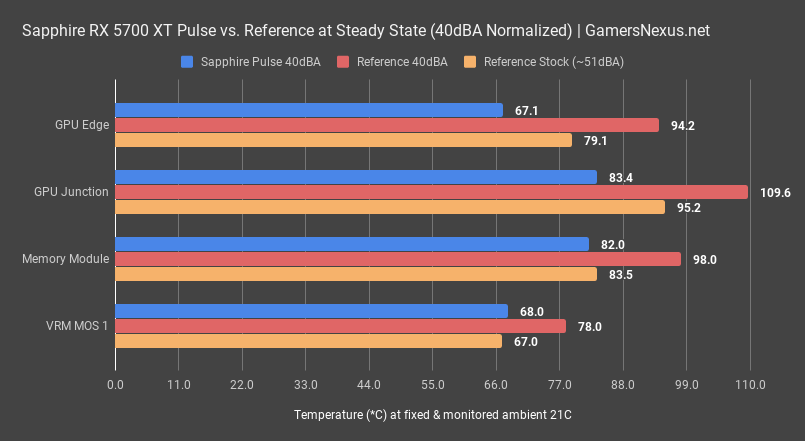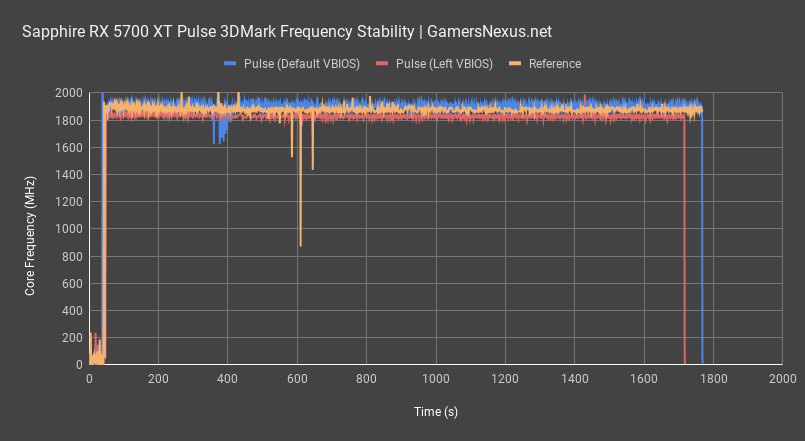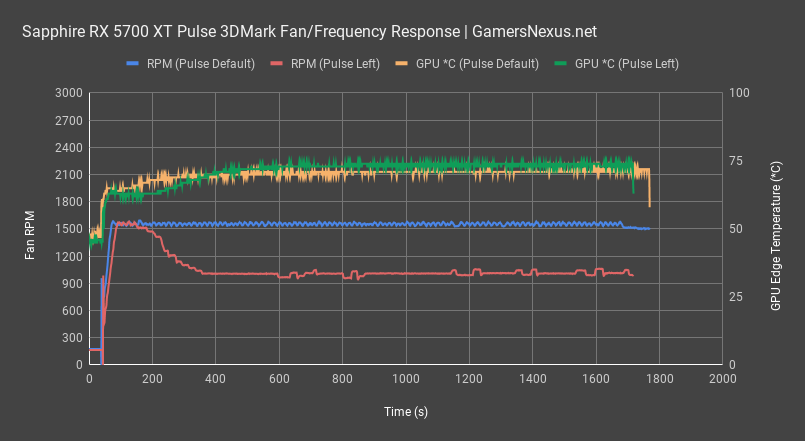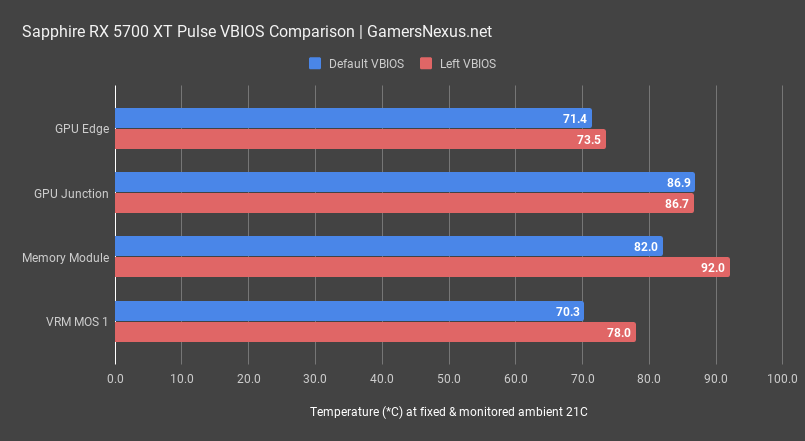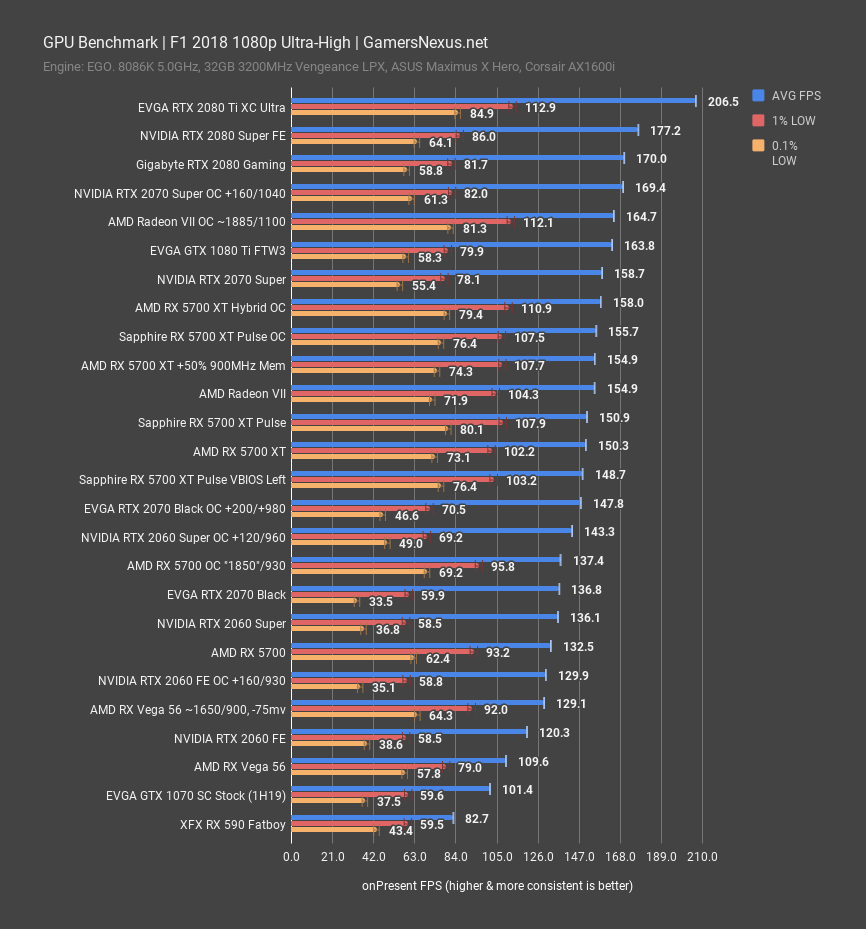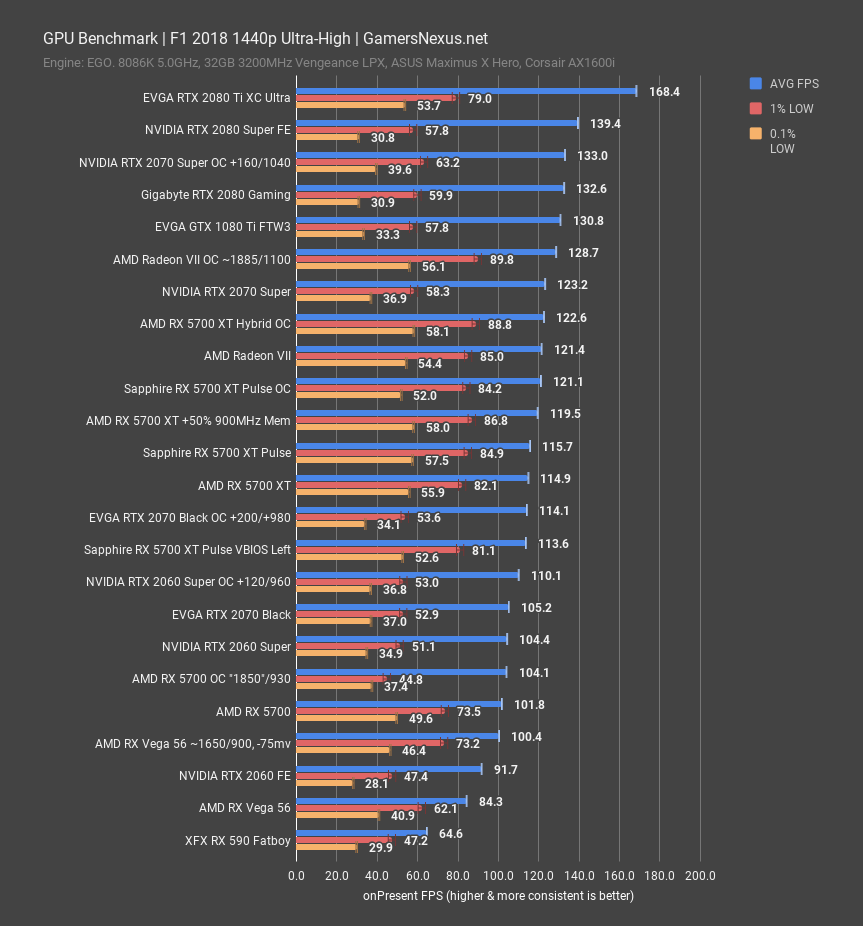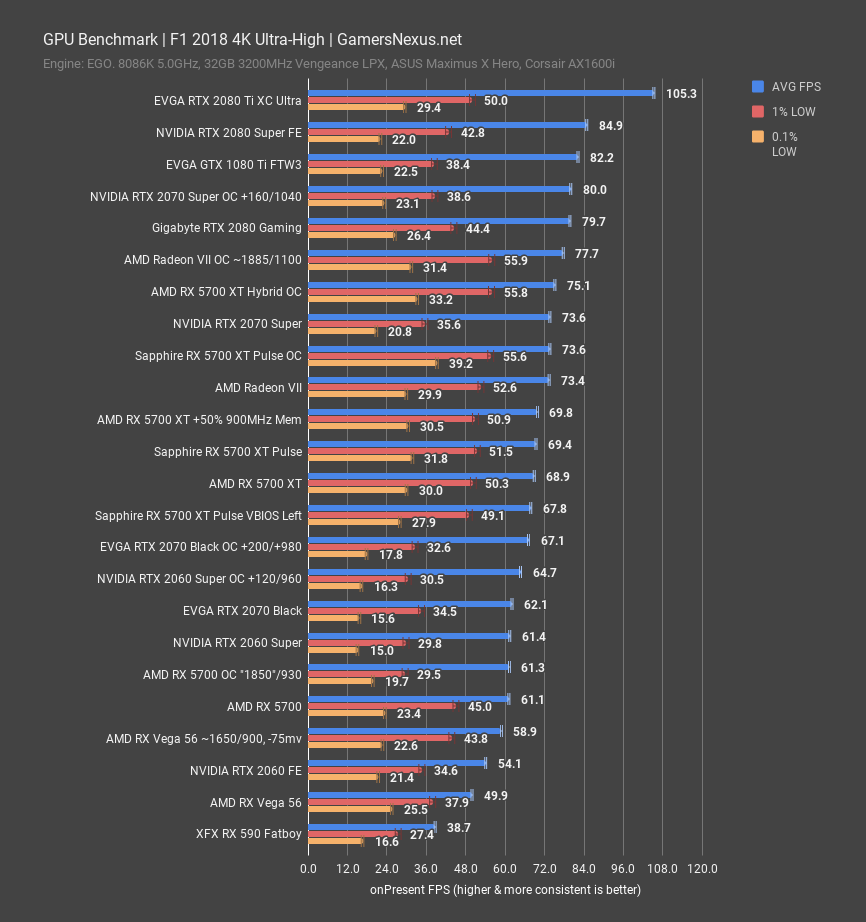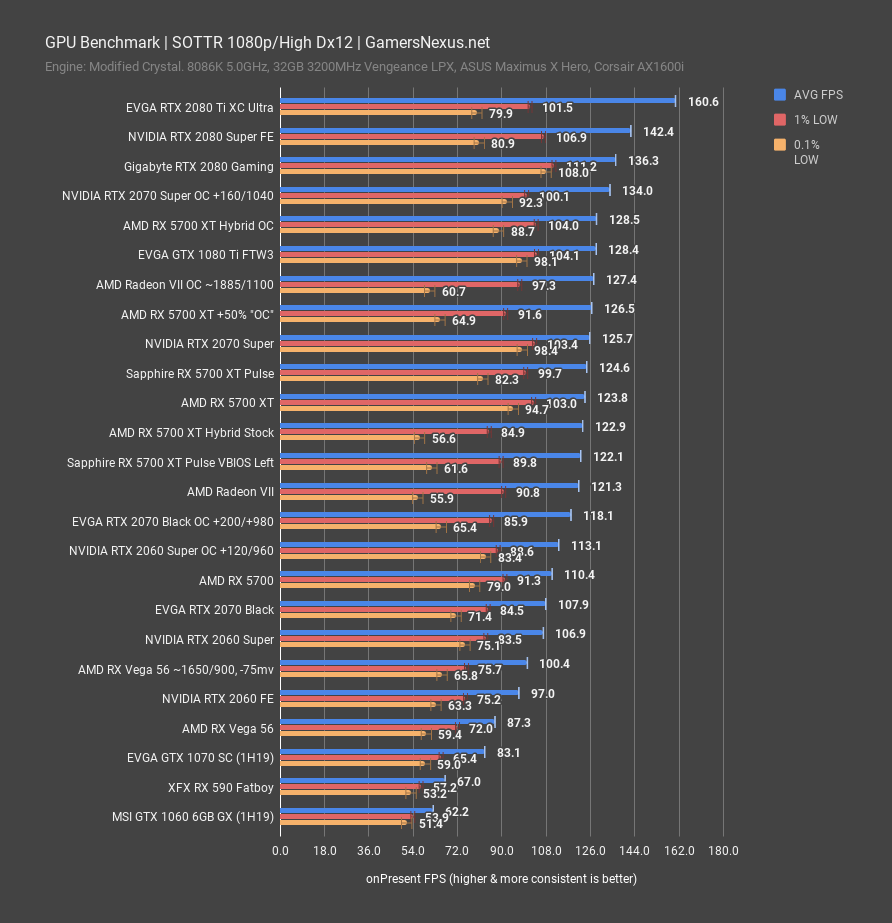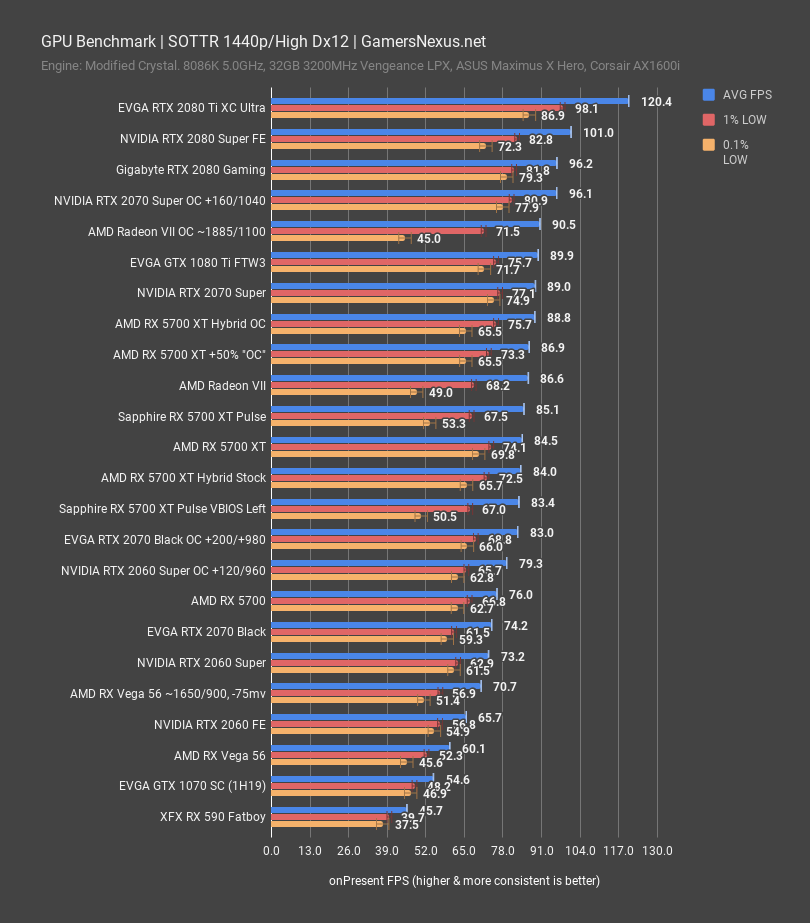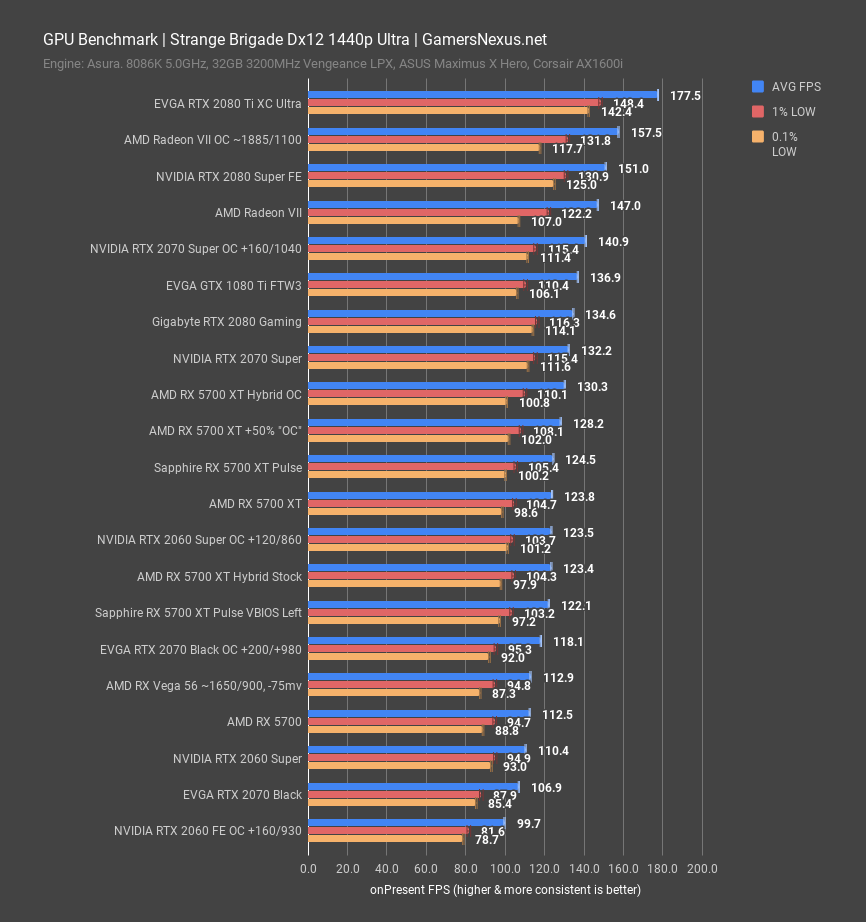Sapphire’s RX 5700 XT Pulse is the first of the non-reference 5700 XT cards we’ll be looking at. Following the RX 5700 XT Reference card review, where our primary complaints revolved around its design being excessively hot and loud, the 5700 XT Pulse bears promise to rectify those issues. Our review will focus almost entirely on thermals and noise, as the gaming performance is largely unchanged. Even in spite of that, though, reducing operating noise levels is a massive quality of life improvement from the reference design, and that’s more exciting than the gaming performance.
Sapphire’s RX 5700 XT Pulse should cost about $10 more than MSRP for the reference 5700 XT, which would put it at around $410 USD at launch. With that price, the reference card will have never made sense to buy, but that’s basically what we said in our launch review.
We’ll talk more about the components and build quality in our upcoming tear-down video of the card, but let’s just get straight into noise and thermals for today’s review.
Test Methodology
We have overhauled the host test bench and had updated with new games. Our games selection is a careful one: Time is finite, and having analyzed our previous testing methodologies, we identified shortcomings where we were ultimately wasting time by testing too many games that didn’t provide meaningfully different data from our other tested titles. In order to better optimize our time available and test “smarter” (rather than “more,” which was one of our previous goals), we have selected games based upon the following criteria:
- Game Engine: Most games run on the same group of popular engines. By choosing one game from each major engine (e.g. Unreal Engine), we can ensure that we are representing a wide sweep of games that just use the built-in engine-level optimizations
- API: We have chosen a select group of DirectX 11 and DirectX 12 API integrations, as these are the most prevalent at this time. We will include more Vulkan API testing as more games ship with Vulkan
- Popularity: Is it something people actually play?
- Longevity: Regardless of popularity, how long can we reasonably expect that a game will go without updates? Updating games can hurt comparative data from past tests, which impacts our ability to cross-compare new data and old, as old data may no longer be comparable post-patch
Game graphics settings are defined in their respective charts.
We are also testing most games at all three popular resolutions – at least, we are for the high-end. This includes 4K, 1440p, and 1080p, which allows us to determine GPU scalability across multiple monitor types. More importantly, this allows us to start pinpointing the reason for performance uplift, rather than just saying there is performance uplift. If we know that performance boosts harder at 4K than 1080p, we might be able to call this indicative of a ROPs advantage, for instance. Understanding why performance behaves the way it does is critical for future expansion of our own knowledge, and thus prepares our content for smarter analysis in the future.
For the test bench proper, we are now using the following components:
GPU Test Bench (Sponsored by Corsair)
Component | Courtesy of | |
CPU | GamersNexus | |
GPU | This is what we’re testing! | Often the company that makes the card, but sometimes us (see article) |
Motherboard | ASUS | |
RAM | Corsair | |
PSU | Corsair | |
Cooler | NZXT | |
SSD | Plextor 256-M7VC | GamersNexus |
All memory timings are completely controlled for our new GPU testing, which has significantly tightened our error margins. Windows is version 1903. Note that some games, like GTA V and Hitman 2, have been manually tuned outside of a simple preset to ensure we have a proper benchmark. GTA V uses 2x MSAA in our testing, as it runs into engine frame limits at 187.5FPS and triggers engine-level bugs. Hitman 2 has crowd simulation and sound simulation settings that we tune back to the 4-core setting, as running higher than that creates a CPU bottleneck (and more of a CPU benchmark, as a result).
Sapphire RX 5700 XT Pulse 40dBA Thermals
Our first chart shows thermals at steady state after a 30-minute power virus workload, measured in a constant ambient temperature of 21 degrees Celsius and monitored every second of the test. The Sapphire RX 5700 XT Pulse clearly solves the reference 5700 XT’s biggest problem outside of launch driver functionality, and that’s the problem of thermals. With both cards locked to a fixed 40dBA, our noise-normalized thermals plot the Sapphire Pulse GPU Edge temperature at 67 degrees Celsius, which is a massive 27.1 degrees Celsius cooler than the reference 5700 XT at the same noise level. If you ran the 5700 XT under auto settings instead, at least with the launch drivers, you’d have found a GPU Edge temperature of 79 degrees in exchange for an 11dBA increase in noise levels. Decibels are logarithmic and human perception is hard to objectively measure, but in our consultation with sound experts, roughly every 10dBA increase results in a 2x perceived increase in noise to the human ear. That’s not the same as the increase in acoustic power, to be extremely clear, but the increase in perceived noise to a human.
GPU Junction temperature, which is the governing temperature for throttling and frequency, plotted at 110 for the reference card at 40dBA. That’s TjMax, so we’re throttling below stock clocks and thus would be even hotter if it were possible. The Sapphire card hits 83 degrees, giving more headroom for lower noise levels at a given frequency and temperature. It’s also a higher frequency, for reference. Even full auto on the blower resulted in 95 degrees for launch.
Memory modules are well under control on the Sapphire card at 40dBA, plotting 82 degrees. The reference 5700 XT’s 98-degree result is in questionable territory where GDDR6 shouldn’t really be operating. Finally, MOSFET temperatures run 68 degrees on the Sapphire Pulse at 40dBA, or 78 degrees on the reference card at an equivalent noise level. If you blow-out the noise to annoying levels, it’s about the same, but noise normalizing really matters here. These VRM MOSFET numbers are fine for both cards, ultimately.
Broll of the card should make it pretty obvious why it’s doing so much better. So far, the Sapphire card is massively improved over reference for thermals, which was our first biggest complaint with the reference card. A few people out there tried to argue that the reference blower wasn’t actually loud or hot, but this is precisely why that’s wrong. It was both objectively hot and objectively loud, particularly in the comparative against partner models. There’s no point in defending a bad cooler design, and Sapphire gives us the numbers to definitively show that there is a better way to make a card. At about $10 more than the reference blower, it’s not even much more expensive.
Sapphire RX 5700 XT Frequency Response
The next chart shows the frequency response of the Sapphire RX 5700 XT for each VBIOS, but also compares to the reference RX 5700 XT AMD card.
Starting with the Pulse’s default VBIOS, the right switch position, the Sapphire card holds a range of about 1880MHz to 1910MHz, bouncing around hard as a result of AMD’s various power, voltage, and thermal thresholds. For comparison, the reference RX 5700 XT by AMD held a range of about 1860MHz to 1906MHz, with the average closer to 1880MHz. The reference card bounces around less dramatically, but also maintains a lower overall average GPU core clock.
Finally, for the left VBIOS switch on the Pulse, frequency starts at around 1830 to 1850MHz, but falls with the rise in thermals to a range of 1815 to 1840MHz, averaging around 1830MHz. This directly correlates with performance, of course, so you’d run a lower FPS in exchange for the lower frequency, but a lower frequency also means the card isn’t working as hard. The left VBIOS is also less sporadic and more stable in frequency, but lower performing overall.
Sapphire RX 5700 XT VBIOS & Fan Speed Comparison
For how this translates to fan speed, here’s the next chart with just the Pulse VBIOS switch positions. The reference card isn’t shown since it’s a different fan, so a direct RPM-to-RPM comparison isn’t linear. Fan speed will be chosen along an RPM-temperature curve, so each VBIOS has a temperature target, then it adjusts the fan to meet that target.
The Pulse with the default BIOS tries to maintain a GPU temperature target of about 71 degrees Celsius edge temperature (not Junction temperature) during load, plotted here. The left VBIOS allows for more silence and enforces a temperature limit of about 74 degrees Celsius, but also downclocks, so it’d be running much hotter here if maintaining the same ~1900MHz clock as the default VBIOS.
As for how fan speed is affect, the default VBIOS pegs the Pulse fan RPM to about 1570, or just under 40dBA at 20” in a room with a noise floor of 26dB. The left VBIOS, the quieter one, pegs RPM to about 1000 after an initial burst period. This heavily controls noise levels and brings the card down to about 33-34dBA on an open air bench and at 20”. In your average computer case, you’d never hear this – but it’d also run at least 5-10 degrees hotter, to be fair. We wouldn’t recommend this VBIOS switch for anyone putting the card under routine heavy loads, but it’d be fine for a user with less heavy usage or a case with a heavy airflow focus.
Memory & VRM Thermals
The next question is how the two different VBIOSes impact VRM and memory thermals. We do a lot of stress testing for thermals with FurMark, but for this, we’re just using a constant 3DMark workload to generate something more similar to a game. Not to be annoying, but again, remember that this is with a lower frequency on the left VBIOS, so the numbers aren’t perfectly and directly comparable. With the default VBIOS, the GPU edge temperature averages to around 71 degrees in 3DMark, or nearing 74 degrees with the other VBIOS. GPU Junction temperature, the hottest spot on the card, is the same in each test – roughly 87 degrees Celsius. This is with ambient accounted for and controlled to 21 degrees, as a reminder. The memory modules show a big difference. Memory on this card benefits a lot from the fan, so dropping to 1000RPM increases the already-hot GDDR6 modules up to about 92 degrees Celsius. In a hot case, that’d be entering dangerous territory for memory, so we’d again advise against using this in hot cases for heavy loads. The VRM MOSFET temperatures also climb about 8 degrees, but we’re still well within reasonable operating range.
Sniper Elite 4
Sniper Elite 4 will start us off for games. Overclocking worked out way better with the Sapphire card than the reference 5700 XT, mostly because our memory was better on the Sapphire card. This is luck of the draw, though, because the memory on our 5700 non-XT was also better than it was on our XT. Full stock, the Sapphire 5700 XT Pulse ends up at 71FPS AVG with the default VBIOS, 69.5FPS AVG with the quieter VBIOS – but note that this would be worse in a hot case – both of which set our framerate within run-to-run variance of the RX 5700 XT reference card’s 71FPS AVG. There’s no improvement at stock when it comes to raw framerate, but again, there’s a bigger picture of noise and thermals; with lower thermals at a given noise level, you can get the same experience for significantly quieter, and that does matter. Further, overclocking actually worked reasonably well on the Sapphire card, almost entirely thanks to the better memory lottery draw where we could hit 950MHz instead of just 900MHz.
The 5700 XT Pulse hit 78FPS AVG when overclocked, with lows scaling similarly and demonstrating that the overclock is stable. 78FPS AVG gives us a gain of almost 10% over the stock Sapphire 5700 XT Pulse or reference card.
F1 2018
F1 2018 is next, giving us a DirectX 11 classic look rather than the previous Dx12 and async compute build. At 1080p, the RX 5700 XT Pulse maintained 151FPS AVG, which is within run-to-run variance of the RX 5700 XT reference card by AMD. Lows are also within the wider variance, so there’s functionally no difference in gaming performance when ignoring thermal, acoustic, and general quality of life improvements from the Sapphire card. Toggling to the quieter VBIOS brought us down to 149FPS AVG and overclocking brought us up to 156FPS on the Sapphire RX 5700 XT with the 950MHz memory and core overclock, resulting in a gain of 3.6% over the stock 5700 XT Pulse.
At 1440p, the 5700 XT Pulse managed 115.7FPS AVG, which is well within variance of the reference 114.9FPS AVG. Lows were also within variance. The quieter VBIOS brings performance down to 113.6, establishing that the default position runs about 1.8% faster than the quieter position; that said, even the default VBIOS is significantly quieter and cooler than the 5700 XT Reference card. Overclocking allowed the Pulse to increase to 121FPS AVG, a 4.7% gain, entirely thanks to that memory bump. At this point, we’re not sure if the core frequency knob is just limited in usefulness, if Navi is limited, or if the drivers need improvement, but we want to see more improvement out of overclocking. Navi really needs the faster memory, though, and that’s more luck-of-the-draw. Comparatively, an RTX 2070 Super is encroached upon by the overclocked 5700 XT cards, and the 5700 XT cards also outperform the 2060 Super’s 104FPS AVG stock position.
At 4K, the 5700 XT Pulse established that it’s still fully capable of 4K gaming with the right games, F1 being one of the easier ones to run, although lows begin suffering as we pump resolution. The reference card’s 68.9FPS AVG and the Pulse’s 69.4FPS AVG are within variance, once again, but overclocking bumped the 5700 XT Pulse to 74FPS AVG. We’re ahead of a 2060 Super with an overclock and, stock-to-stock, behind a 2070 Super without any tuning. The 2070 Super stock maintains a lead of about 6% over the Pulse when stock.
Shadow of the Tomb Raider
Shadow of the Tomb Raider with Dx12 is next. 1080p has the RX 5700 XT at 124FPS AVG for the reference model, with the Pulse also at about 124-125FPS AVG. There’s no straight benefit, once again, other than the other quality-of-life improvements discussed earlier. It’s not like just buying a partner model will immediately improve FPS. We dropped the overclocking numbers at this point, because Shadow of the Tomb Raider with any overclock on our Pulse would trigger a hard shutdown. Just a black screen, the same behavior as an OCP would trigger. Even dropping to 920MHz memory caused this hard crash, so we ended up giving up on overclocking numbers from this point on and just focused on the basics. It seems AMD still has a ton to fix in its broken overclocking behavior for the Navi series cards, but at least Sapphire picked-up the slack on the cooler.
At 1440p, the RX 5700 XT Pulse runs at 85FPS AVG, which is about the same as the 84.5FPS of the reference card. The left VBIOS drops to 83.4FPS AVG, allowing the default VBIOS a lead of 2% on the Pulse card. Nothing else here is really worth talking about since it’s the same numbers as the reference review, aside from noise and thermals.
There’s a clear trend here, so no point in showing 4K numbers. Go check our reference 5700 XT review if you want that. We’ll move on.
Strange Brigade [Dx12]
Strange Brigade with DirectX 12 is up next. As a reminder, AMD’s been doing better in Dx12 with some cards in Strange Brigade than with Vulkan. At 1440p, the 5700 XT Pulse stock VBIOS runs at 124.5FPS AVG, within variance of the 123.8FPS AVG of the reference card. The left VBIOS drops down to 122FPS AVG.
We’re going to stop at this point. We have numbers for Strange Brigade at 4K, with Vulkan, we have numbers with Hitman 2 in Dx12 and Dx11 at 3 resolutions each, we have Far Cry 5 and GTA V, but none of it matters. At the end of the day, raw FPS is equal between reference and the Pulse, so you can check our original review for the rest of those numbers. It’s all about thermals and noise for this card.
Conclusion
Sapphire’s done a good job with its Pulse cooler for the 5700 XT. Thermals and noise levels are drastically improved, with the Pulse actually being able to maintain 40dBA noise levels at almost 30 degrees lower edge temperature. Memory temperatures are also dropped to the 80s from nearly 100 degrees Celsius at 40dBA, which is a big step-up. If you’re buying an RX 5700 XT for sure, we have no issues recommending the Sapphire Pulse. It’s tremendously improved over the reference model.
The biggest downside here is still AMD’s drivers. The issue where the screen flashes various colors on install seems to be fixed, finally, so at least users don’t get that as their out-of-box experience. That’s a good improvement, but it never should have been broken to begin with. Overclocking and fan changes are still broken:
- Setting a fan speed does not apply under idle, so if you want the fan to spin at 40% at all times, it won’t actually start spinning until there’s GPU load. We view this as unexpected behavior for software. If the user sets a fan speed override, by nature of being an override, the fan should spin at that speed at all times. For fan noise testing, we actually had to run 3DMark in the background just to change the fan speeds. Normally, we can do it idle from desktop.
- Setting a higher fan speed does not allow it to come back down. If you set a fan speed of 90% and then try to back it down to 80%, you basically have to restart to change the fan speed, or wait a very long time – long enough that, after a few minutes, we gave up and just restarted. This has been a bug since Vega: Frontier Edition and is incredibly annoying. It exists in Afterburner and WattMan, so must be an API issue.
- The new driver has black screen hard crash/lock issues that resemble OCP when attempting overclocking in some games, even though the overclock validates as stable.
- Overall, the drivers are good enough that most people won’t notice the many minor annoyances that exist. You’ll probably be able to game without encountering issues, it’s just the hardware tuners who should be advised of these concerns.
As for the card itself, we have absolutely no problem recommending the Sapphire Pulse version of the 5700 XT. Again, Sapphire has done well to build a cooler that is effective in thermals and noise levels and smashes the reference design for noise normalized performance. If you were buying an RX 5700 XT, the Pulse is a fine card and a much better choice than the reference model. We haven’t tested the other models yet, but Sapphire’s is certainly in territory where further thermal improvement won’t necessarily meaningful gains.
Editorial, Testing: Steve Burke
Video: Andrew Coleman
